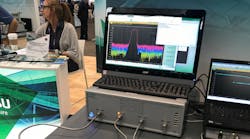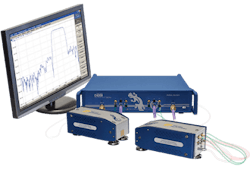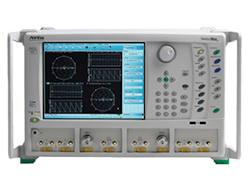Measuring an Industry’s Quickening Pace at IMS
Test equipment has long been a form of signpost, indicating where the RF/microwave industry is going, and the 2019 IEEE International Microwave Symposium (IMS) exhibition did not disappoint in its messages. The test gear on display in the Boston Conference and Exhibition Center (BCEC) represented several trends for where the industry might be heading in the next few years.
Many booths showed signal generators and analyzers for several potentially huge markets in the fifth generation (5G) of cellular wireless communications networks and in the electronification of motor vehicles. Both markets are expected to require test instruments for signal generation and analysis at millimeter-wave (mmWave) frequencies, with many visitors to the exhibition explaining that their own needs are for the highest test frequencies possible.
To achieve the high data rates required for future wireless-communications systems, low phase noise is mandatory, and this parameter was a leading focus for many of the top source manufacturers at the 2019 IMS, such as Synergy Microwave Corp. (Booth 750) and Micro Lambda Wireless (Booth 1104). These and many other oscillator and frequency-synthesizer designers were reaching for “new lows” in phase noise as close to the carrier as possible.
Synergy showed several wideband RF/microwave voltage-controlled oscillators (VCOs) with extremely fast tuning speeds for high-speed systems in communications and test, while Micro Lambda Wireless spotlighted its specialties in very clean yttrium-indium-garnet (YIG) oscillators and frequency synthesizers. These and many other source suppliers displayed impressive phase-noise numbers at offset frequencies close to microwave carriers. Their challenges were in measuring those new lows in phase noise.
To accommodate such designers, many of the test-equipment developers at the exhibition, including Keysight Technologies (Booth 606), Rohde & Schwarz (Booth 642), and National Instruments (Booth 930), were showing the types of performance required for measuring low noise levels, in both signal generators and signal analyzers.
Rohde & Schwarz, for example, brought its R&S SMA100B signal generator with near 20-GHz bandwidth and impressive phase-noise numbers to compare to the signal sources it must measure. With high output-power levels of better than +30 dBm at 20 GHz, this test signal source can reach phase noise of less than −152 dBc/Hz offset 20 kHz from a 1-GHz carrier and less than −132 dBc/Hz offset 20 kHz from a 10-GHz carrier. Even the spurious signal levels are low, at −110 dBc. The firm also showed signal analyzers with the capabilities to investigate fixed-frequency and tunable oscillators possessing the lowest noise levels.
One of the major trends in test at the 2019 IMS was the steady move of the industry away from traditional 19-in. rack-mount test instruments and more to the adoption of small, compact, plug-in modules, such as PXI-based instruments that allow a user to add as much performance as needed to a mainframe. National Instruments was a strong contender in the center of the show floor with its many measurement solutions. Another new trend that was evident is test instruments with Universal Serial Bus (USB) connections to a PC.
1. A growing trend in RF/microwave test is the miniaturization and modularity of measurement equipment, such as mmWave VNAs. (Courtesy of Copper Mountain Technologies)
As an example, Copper Mountain Technologies (Booth 1160) was showing examples of its USB vector network analyzers (VNAs) that visitors could “test” out. When equipped with the company’s CobaltFx extensions, these compact VNAs (Fig. 1) can provide analysis to 110 GHz.
Perhaps the most striking development on the measurement side of things was at the Anritsu display (Booth 542), which put the spotlight on the latest VectorStar VNA for mmWave signal analysis (Fig. 2). Existing models operate to 70 GHz, but a soon-to-be-introduced model handles 70 kHz to 220 GHz in a single sweep. Much of the talk on the show floor had to do with the coming of 5G cellular wireless communications systems and automotive radar systems at mmWave frequencies and how to test them; Anritsu is looking beyond the talk and providing an analysis solution to 220 GHz.
2. One of the more impressive announcements in test equipment at the 2019 IMS exhibition was the introduction of a 220-GHz coaxial VNA for on-wafer measurements. (Courtesy of Anritsu Co.)
What was so amazing was its connectors: not waveguide, but coaxial connectors. They provided the interfaces to on-wafer probes for testing across that continuous bandwidth. This coming from the company that developed the K connector many years ago to bring the industry’s coaxial connectors to the mmWave frequency range. This is a story worth watching and one to follow. The official launch of the VectorStar 220-GHz system is slated for later in 2019.



